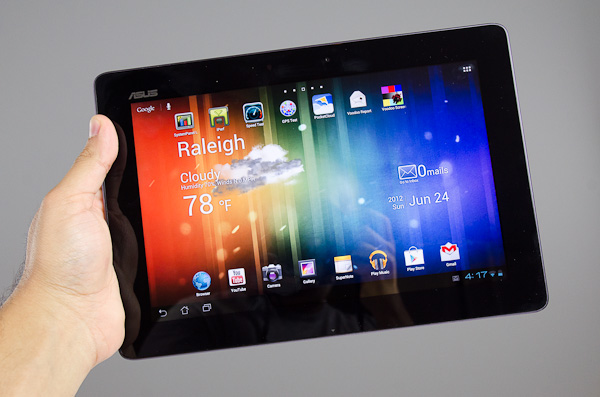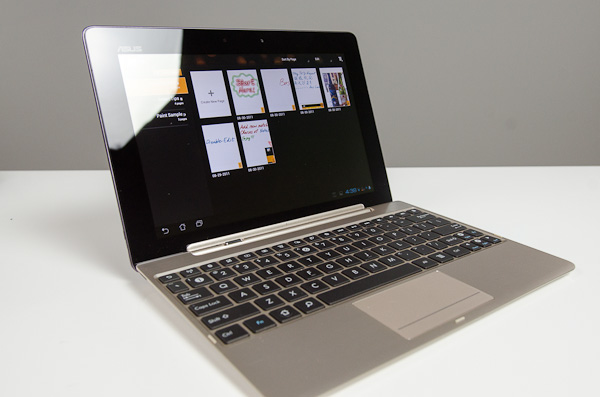ASUS Transformer Pad Infinity (TF700T) Review
by Anand Lal Shimpi on June 25, 2012 3:00 AM ESTAt Computex a few weeks ago ASUS gave us exactly what we had been hoping for: a Transformer-style tablet running Windows 8. In fact, ASUS gave us a bunch of options as far as Windows 8 tablets go. The two we've been asking for are the Tablet 600 and Tablet 810, running Windows RT and Windows 8, respectively. They feature standalone tablets with detachable keyboard/mouse docks, giving you the best of both worlds.
ASUS wasn't the only one to bring this sort of flexibility to Windows 8. Acer showed off a similar design with its Iconia W510, as did Samsung and more recently, Microsoft. With the Surface tablets Microsoft actually went a step further and tried to integrate the keyboard into a lightweight cover rather than an external dock. It remains to be seen just how well these approaches will work, but it's clear there's a trend for the first generation of Windows 8 tablets.
We can't forget however what started this all. Much like Apple with the iPhone and iPad, ASUS picked an intersection of functionality and technical feasibility with the introduction of the first Eee Pad Transformer. For the first time we had silicon capable of running for hours in a small form factor tablet, as well as a touch-enabled OS that could run on it. Previous attempts at hybrid tablets often tried to shoehorn a desktop version of Windows into a device that was too clumsy. ASUS' Transformer series was the start of something new.
Since the release of the first Eee Pad Transformer (can you believe it's only been about a year?), ASUS has released several members of the Eee Pad and Transformer families. We got a slider, a thinner version called the Transformer Prime, as well as a refreshed entry level Transformer Pad 300. ASUS' experimentation and learning will pay off later this year as it ships the first Windows RT/8 versions. Until then however ASUS isn't done iterating. Today it's officially announcing the final configuration of the Transformer Pad Infinity, the first member of the TF series with a 1920 x 1200 display. It also happens to be the first tablet we've tested to use NVIDIA's higher binned Tegra 3 T33 SoC.
| ASUS Tablet Specification Comparison | ||||||
| ASUS Eee Pad Transformer | ASUS Transformer Pad 300 Series | ASUS Eee Pad Transformer Prime | ASUS Transformer Pad Infinity | |||
| Dimensions | 271mm x 175mm x 12.95mm | 263 x 180.8 x 9.9mm | 263 x 180.8 x 8.3mm | 263 x 180.6 x 8.4mm | ||
| Chassis | Plastic | Plastic | Aluminum | Aluminum + Plastic RF Strip | ||
| Display | 10.1-inch 1280 x 800 | 10.1-inch 1280 x 800 IPS | 10.1-inch 1280 x 800 Super IPS+ | 10.1-inch 1920 x 1200 Super IPS+ | ||
| Weight | 675g | 635g | 586g | 594g | ||
| Processor | 1GHz NVIDIA Tegra 2 (2 x Cortex A9) |
NVIDIA Tegra 3 (T30L - 4 x Cortex A9) |
1.3GHz NVIDIA Tegra 3 (T30 - 4 x Cortex A9) |
1.6GHz NVIDIA Tegra 3 (T33 - 4 x Cortex A9) |
||
| Memory | 1GB | 1GB | 1GB | 1GB DDR3-1600 | ||
| Storage | 16GB + microSD card | 16GB/32GB | 32GB/64GB + microSD slot | 32/64GB + microSD slot | ||
| Battery | 24.4Whr | 22Whr | 25Whr | 25Whr | ||
| Pricing | $399 | $379/$399 | $499/$599 | $499/$599 | ||
Despite early indications of $599+ pricing, the Transformer Pad Infinity comes in at $499 for the 32GB model and $599 for 64GB. The Infinity is compatible with the Transformer Dock ($149) from the TF Prime as long as your dock has firmware 207 or later on it. The dock is what gives the Transformer Pad its name as it allows the Infinity to be converted into an Android netbook complete with QWERTY keyboard, trackpad and additional battery. The Infinity and its dock are available in the same two colors (amethyst gray and champagne gold) as the TF Prime was at launch. The Infinity dock doesn't appear to carry a separate part number, it's literally the same dock that was used with the Prime.
The chassis hasn't changed much since the introduction of the Prime. It is one-tenth of a millimeter thicker to accommodate the higher-resolution display and backlight assembly, but battery capacity remains at 25Wh. The Infinity is a little heavier and its edges are squared a bit instead of being perfectly rounded. The port configuration remains the same (micro HDMI, micro SD, headphone jack), although redistributed around the chassis. The power and volume buttons are now both located along the top of the unit, with the switches themselves more integrated with the tablet.
Although official reviews of the Infinity hit today, availability isn't scheduled until around July 16th. Quantities are unknown at this point and will likely be gated by panel availability.



















112 Comments
View All Comments
Screammit - Tuesday, June 26, 2012 - link
sadly, "tinkering" for 90% of the public is to change their background picture.Belard - Tuesday, June 26, 2012 - link
" I’m only afraid they will end up being too schizophrenic for that, trying to do it all and ending up doing nothing well enough for people to give a shit."BINGO!
andrewaggb - Monday, June 25, 2012 - link
Personally I haven't been able to use either for work. The TF + dock is almost usable, but it doesn't have enough of the apps I use (I don't want lame substitutes) and ultimately the tf+dock is almost a netbook... so I just use my much more powerful laptop. The ipad is not work worthy. And apple doesn't try to market it that way, so I'm ok with that. I love the ipad for what it is, instant-on, relax on the couch.Surface may be suitable for light work, though I'm not sure how it will work in your lap, so the asus version will probably be better. But I suspect it'll take a good year for the apps to be available for ARM, so at launch I'd be looking at an x86 version... and it doesn't look like AMD or Intel has a tablet winner SOC for the fall. Ivy Bridge will do, but haswell would have been better. And an ultra low voltage trinity maybe?
I'm not certain that when the dust settles I'm going to want to work on a tablet with a keyboard anyways. I like the idea of one less device, but maybe it's a dream. I think phone,tablet,laptop,desktop,xbox/appletv, all play a somewhat different role and I'll probably keep buying all of them.
I like the concept of running windows 8 on everything, but I'm currently mixing android,apple,and lots of microsoft and I'm getting along just fine :-)
kmmatney - Monday, June 25, 2012 - link
" BUT what disadvantages do you get? On Android I have none, except of voiding my warranty."I have my iPad 2 Jailbroken, and there are no disadvantages - at least none that I've ever come across. The advantage is being able to install RetinaPad, iFile, NES emulators with Wiimote support, and a few UI customization apps.
DeciusStrabo - Tuesday, June 26, 2012 - link
My iPad 2 slowed down a lot when I jailbroke it and installed some jailbroken software. It was rather annoying and the reason I went back into Apple's golden cage. No such issue with rooted/custom-ROM Android, where you rather see a stability and speed increase, not a decrease.BabelHuber - Monday, June 25, 2012 - link
I miss tests of actual games on the TF Infinity.The TF Prime is a real joy in this regard. Shadowgun, GTA3, Max Payne, N:OV.A. 3, everything is running smooth like butter, but only at 720p.
How does the TF Infinity play these games? With its 1080p resolution the GPU has much more to do, especially the Pixel Shaders.
So, does the higher-clocked Tegra 3 with its enhanced bandwith compensate for the higher screen resolution?
XZerg - Monday, June 25, 2012 - link
^^ when?bleh0 - Monday, June 25, 2012 - link
I love the form factor of the Transformer series but it needs RT. With Nvidia being the ARM partner for Microsoft at the moment we might see better battery life and performance out of RT then under Android. As always I'll be waiting patiently for the Anandtech review when the device is released.jwcalla - Monday, June 25, 2012 - link
Maybe slapping Ubuntu for Android would help seal the deal on this thing. You get the "hybrid device" feel that Windows is going for, plus you have the Android app ecosystem to work with.Quad-core Cortex A15s will be interesting as you could run two operating systems (like Ubuntu and Android) simultaneously. And Ubuntu is surprisingly mature and smooth on ARM w/ GPU acceleration.
riottime - Monday, June 25, 2012 - link
it's alright tablet but i'll wait for win8 surface. i own ep121 and it's still working great with i5 cpu. i might just upgrade the os on it to win8 when that comes out instead of buying a brand new 'surface' tablet. as for android, my samsung player 4 is sufficient. :)